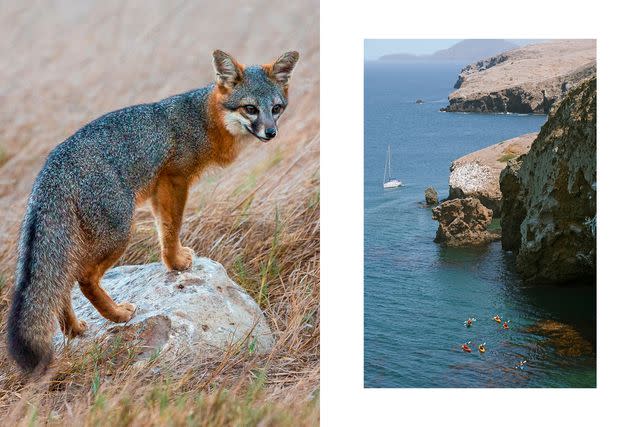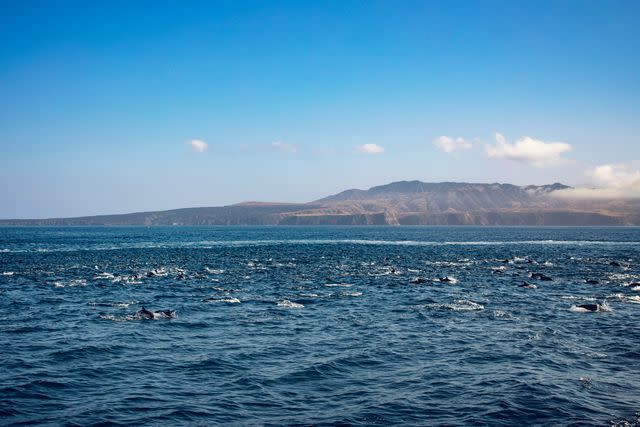These Wild Islands Off the Coast of Southern California Offer a Quiet, Less-visited Nature Escape
Channel Islands National Park isn’t far from Santa Barbara, but this ecologically rich archipelago is anything but familiar.

Russ Bishop/Alamy
From left: Santa Cruz Island has one of the world's largest sea caves; hiking in Lobo Canyon, on Santa Rosa Island.Walking the trail that led to Lobo Canyon felt like being on a different planet. Arid terrain gave way to steep sandstone cliffs that towered above lush greenery and spiny cacti, an intriguing mishmash of environments. At times I had to be a contortionist, ducking under the low-hanging limbs of island oak trees, scrambling up and over rocks, and walking across a wobbly hardwood plank suspended over a creek. Forcing my way through a thick tangle of reeds was slightly suffocating; I felt I might actually be swallowed up by Santa Rosa island, never to be seen again. But then the canyon opened and the trail rose upward. After a few more minutes, I stood overlooking a white beach and the Pacific Ocean. The beach was entirely free of other visitors and — judging by the absence of footprints in the sand — had been for some time.
This, I thought, is why I came to Channel Islands National Park, a chain of five islands less than 15 miles off the coast of Santa Barbara and Ventura, California. Each of the islands — Anacapa, Santa Barbara, Santa Cruz, Santa Rosa, and San Miguel — has its own unique appeal, and collectively they’re often referred to as the Galápagos of North America, thanks to the 145 endemic species found nowhere else in the world.
Despite these natural wonders and the park’s proximity to the mainland, only about 320,000 people visited in 2022. That’s fewer than the number of people who went to Yosemite National Park during a single month last summer. Maybe those numbers have something to do with the kind of place it is: unlike parks where you can get out of your car and walk 10 steps to a scenic viewpoint, this one makes you earn your Instagram photos. You can reach the park only by commercial ferry or private boat; once there, you get around on foot. All the food and gear I needed for my six-day stay had to be carried in my overflowing backpack. There are no convenience stores, not even a gift shop; if I had forgotten anything, I’d need to do without.
Even for those who aren’t keen to rough it, the wildlife and natural beauty are powerful draws. There’s also an anthropological reason to visit: in 1959, researchers in the park discovered some of the oldest human remains in North America, dating back at least 13,000 years. (They are believed to be ancestors of the present-day Chumash people.)
“When we think of ancient human history, many of us think of Egypt and the pyramids,” Russell Bradley, director of California State University’s Santa Rosa Island Research Station, later told me. “The pyramids were erected about 4,500 years ago, but humans were living and thriving on the Channel Islands for nearly 9,000 years before that.”

From left: BLUEBARRONPHOTO/SHUTTERSTOCK; ATSUO BABA/ISTOCKPHOTO/GETTY IMAGES
From left: A fox native to the Channel Islands is about the size of a house cat; kayaking in Channel Islands National Park, off the coast of California.My October visit coincided with the park’s dry season, but in the spring, wildflowers bloom and the land explodes with color. I went to two of the five islands — first to Santa Rosa, then to Santa Cruz. Santa Rosa is one of the more rustic islands in the chain and takes approximately three hours to reach by boat from the mainland. “Santa Cruz gets three or more ships a day,” Dylan Moe, a Santa Rosa ranger told me. “But this time of year, we get three a week if we’re lucky.”
To reach Water Canyon, and my campsite, I walked a mile and a half across rolling hills and wide-open prairie. Shortly after setting up my tent, I noticed several hunched eucalyptus trees. I’d later learn that these trees aren’t native, but were planted as windbreaks by European settlers; the area’s powerful gusts cause them to grow stooped over.
I also spotted an island fox, a house-cat-size species that is the park’s largest land mammal. The animal’s diminutive size can be chalked up to the “islands rule,” park ranger Madeleine Whitman told me. “Most of the species on the islands are either much smaller or much larger than their mainland counterparts,” she said. For example, the island scrub jay is larger than jays on the mainland, likely because of an abundance of food and the absence of predators. In contrast, foxes are smaller because of resource constraints.
That night, I learned how intense the wind could be as it whipped through the canyon, repeatedly extinguishing my camp stove. But when it died down, I was rewarded with an expansive view of the stars — being so far from the mainland, Santa Rosa has some of the darkest night skies in the national park system.

Flying Dawn Marie
A pod of common dolphins near Santa Cruz Island.After three days of exploring Santa Rosa, I moved on to Santa Cruz, the most frequently visited island. During the ferry ride, pods of common dolphins crossed the boat’s path, leaping and playing in its wake. We also passed hundreds of California sea lions sunning themselves on ocean buoys and rocks.
Among Santa Cruz’s main attractions are its sea caves — it has one of the highest concentrations of them in the world. I joined a group of other visitors and a guide with Channel Islands Adventure Co. to explore more than a dozen of these rock formations by kayak. Some were huge, like the famous Painted Cave, where the volcanic-rock walls transform from black to a kaleidoscope of colors. Others were claustrophobic, with small entrances that led to darker secondary caverns that got exponentially narrower. In some, the only light that has ever shone has been a guide’s flashlight. One was so tiny it was difficult to even turn around; at one point, I accidentally wedged my paddle between the cavern walls and had to yank it free. I nearly tumbled out of my kayak.
The caves were beautiful, intriguing, and, at times, frightening. Navigating them was a fitting end to my adventure on the Channel Islands, a place I found isolating, and inspiring, and unlike any other in America I’d seen.
How to Visit the Channel Islands
Getting There
Island Packers Cruises runs daily summer service to Santa Cruz Island and operates on a limited schedule to the other islands.
What to Do
Channel Islands Adventure Co. offers sea-cave kayaking tours, as well as snorkeling tours.
Where to Stay
Basic campsites are available on all five islands and must be reserved in advance. Visitors need to bring their own food and water.
A version of this story first appeared in the August 2023 issue of Travel + Leisure under the headline "Wild Kingdom."
For more Travel & Leisure news, make sure to sign up for our newsletter!
Read the original article on Travel & Leisure.

